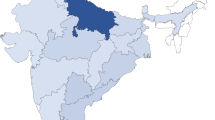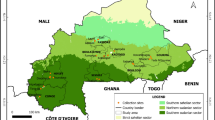Abstract
The morphological variation of 81 garden cress including 77 accessions of Genebank Department of Leibniz Institute of Plant Genetics and Crop Plant Research in Gatersleben, Germany and four ancient varieties collected from different geographical and bioclimatic areas of Iran were assessed based on 19 morphological traits. The genotypes were grown according to simple lattice design with four replications across 2 years (2012 and 2013). Significant differences among accessions were revealed for the majority of traits. The coefficient of variation varied from 18.05 (number of seeds per silique of lateral branches) to 52.79 % (biological yield) in the first year and varied from 9.12 (number of seeds of silique per plant) to 36.05 % (biological yield) in the second year. The first four factors explained 83.92 % of the total variation at year 2012 while the first four factors explained 76.93 % of the total variation at year 2013 among 81 of garden cress accessions. At both years, days to flowering, days to maturing, height of first branch and height of first silique, number of silique per lateral branches and number of siliques per plant were the most important traits contributing to the first two factors. This indicates that breeding programs should be based on these traits for improvement of garden cress. The regions of origin of the accessions were dispersed in ten sub-units which the first factor axis was much more important than the second one in separating the regions of origin of the accessions and separated sub-units five from four other sub-units, but this factor axis could not separate accessions of sub-unit I. Based on the observed structures of variation, it is concluded that the magnitude of morphological variation in the material studied is high and the implications of the results for plant breeding programs are discussed. The results of the present study can be used for breeding and improvement of garden cress for various desired traits through hybridization in future.



Similar content being viewed by others
References
Bandila S, Ghanta A, Natarajan S, Subramonia S (2011) Determination of genetic variation in Indian sesame (Sesamum indicum) genotypes for agro-morphological traits. J Res Agric Sci 7:88–99
Bansal D, Bhasin P, Yadav OP, Punia A (2012) Assessment of genetic diversity in Lepidium sativum (Chandrasur) a medicinal herb used in folklore remedies in India using RAPD. J Genet Eng Biotechnol 10:39–45
Bedassa T, Andargie M, Eshete M (2013a) Genetic variability and association among yield, yield related traits and oil content in Ethiopian garden cress (Lepidium sativum L.) genotypes. J Plant Breed Crop Sci 5:141–149
Bedassa T, Andargie M, Eshete M (2013b) Genetic divergence analysis of garden cress (Lepidium sativum L.). J Plant Breed Crop Sci 5:770–774
Bermejo JEH, Leon J (1994) Neglected horticultural crops. Plant Production and Protection Series. FAO, Rome
Cheema KL, Iqbal M, Niaz S, Shafique M (2011) Assessment of variability of muskmelon. Int J Veg Sci 17:322–332
Dayal N, Singh SN (1985) Inbreeding depression in chromosome behaviour of the garden cress (Lepidium sativum L.). Cytologia 50:289–300
Gabay MP (2002) Galactogogues: medications that induce lactation. J Hum Lactation 18:274–279
Hegay S, Geleta M, Bryngelsson T, Asanaliev A, Garkava-Gustavsson L, Hovmalm HP, Ortiz R (2014) Genetic diversity analysis in Phaseolus vulgaris L. using morphological traits. Genet Resour Crop Evol 61:555–566
Ivanovska S, Stojkovski C, Dimov Z, Marjanovic-Jeromela A, Jankulovska M, Jankuloski L (2007) Interrelationship between yield and yield related traits of spring canola (Brassica napus L.) genotypes. Genetika 39:325–332
Lanner-Herrera C, Gustafsson M, Falt AS, Bryngelsson T (1996) Diversity in wild populations of Brassica oleracea as estimated by isozyme and RAPD analysis. Genet Resour Crop Evol 43:13–23
Li Y, Zhang T, Korkaya H, Liu S, Lee HF, Newman B, Yu Y, Clouthier SG, Schwartz SJ, Wicha MS, Sun D (2010) Sulforaphane, a dietary component of broccoli/broccoli\sprouts, inhibits breast cancer stem cells. Clin Cancer Res 16:2580–2590
Majeed A, Ahmad H, Muhammad Z (2010) Variation in chlorophyll contents and grain yield of Lepidium sativum L. as induced by gamma irradiation. Int J Biol Sci Eng 1:147–151
Marjanovic-Jeromela A, Marinkovi R, Mijic A, Zdunic Z, Ivanovska S, Jankulovska M (2008) Correlation and path analysis of quantitative traits in winter rapeseed (Brassica napus L.). Agric Conspec Sci 73:13–18
Million F (2011) Genetic divergence in Ethiopian Fenugrek landraces: morpho-physiological and nodulation traits in Ethiopian fenugreek (Trigonella foenum-graecum L.) landraces. LAP LAMBERT Academic Publishing
Minitab (2014) Minitab user’s guide, version 17. Minitab Inc, Harrisburg
Nooryazdan H, Serieys H, Bacilieri R, David J, Berville A (2010) Structure of wild annual sunflower (Helianthus annuus L.) accessions based on agro-morphological traits. Genet Resour Crop Evol 57:27–39
Ozer H, Oral E, Dogru U (1999) Relationship between yield and yield components on currently improved spring rapeseed cultivars. Turk J Agric For 23:603–607
Parsa A (1960) Medicinal plants and drugs of plant origin in Iran. IV. Plant Foods Hum Nutr (Former Qual Plant) 7(1):65–136
Povalyaeva IA (1981) Anatomical peculiarities of the vegetative organs of the cress. Byull Vses Ord Lenina Inst Rast NI Vavilova 109:48–51 [In Russian]
Rao VR, Hodgkin T (2002) Genetic diversity and conservation and utilization of plant genetic resources. Plant Cell Tissue Org Cult 68:1–19
Sabaghnia N, Dehghani H, Alizadeh B, Mohghaddam M (2010) Interrelationships between seed yield and 20 related traits of 49 canola (Brassica napus L.) genotypes in non-stressed and water-stressed environments. Span J Agric Res 8:356–370
Sabaghnia N, Asadi-Gharneh HA, Janmohammadi M (2014) Genetic diversity of spinach (Spinacia oleracea L.) landraces collected in Iran using some morphological traits. Acta Agric Slov 103:101–111
SAS (2004) SAS/STAT guide for personal Computer, Proprietary software Version 9.1 SAS Institute Inc., Cary. NC. USA
Sat IG, Yildirim E, Turan M, Demirbas M (2013) Antioxidant and nutritional characteristics of garden cress (Lepidium sativum). Acta Sci Pol Hortorum Cultus 12:173–179
Sharma S, Agarwal N (2011) Nourishing and healing prowess of garden cress (Lepidium sativum Linn.): a review. Indian J Nat Prod Resour 2:292–297
Snedecor GW, Cochran WG (1981) Statistical methods, 6th edn. Iowa State Univ. Press, Ames
Souri E, Amin GH, Farsam H, Andaji S (2004) The antioxidant activity of some commonly used vegetables in Iranian diet. Fitoterapia 75:585–588
Sumeet D, Ritesh P, Sudeep K, Reneesh J, Sudhish R, Alok S (2010) Quantitative estimation of fixed oil obtained from seeds of Lepidium sativum Linn. Int J Chem Anal Sci 1:6–9
Szamosi C, Solmaz I, Sari N, Baársony C (2010) Morphological evaluation and comparison of Hungarian and Turkish melon (Cucumis melo L.) germplasm. Sci Hortic 124:170–182
Trimech R, Zaouali Y, Boulila A, Chabchoub L, Ghezal I, Boussaid M (2013) Genetic variation in Tunisian melon (Cucumis melo L.) germplasm as assessed by morphological traits. Genet Resour Crop Evol 60:1621–1628
Uddin MJ, Chowdhury MAZ, Mia MFU (1995) Genetic variability, character association and path analysis in Indian mustard (Brassica juncea L.). Ann Bang Agric 5:51–54
Acknowledgments
Sincere gratitude goes to Genebank Department of Leibniz Institute of Plant Genetics and Crop Plant Research (IPK; Institut für Pflanzengenetik und Kulturpflanzenforschung) in Gatersleben, Germany for providing plant materials.
Author information
Authors and Affiliations
Corresponding author
Rights and permissions
About this article
Cite this article
Sabaghnia, N., Ahadnezhad, A. & Janmohammdi, M. Genetic variation in garden cress (Lepidium sativum L.) germplasm as assessed by some morphological traits. Genet Resour Crop Evol 62, 733–745 (2015). https://doi.org/10.1007/s10722-014-0192-4
Received:
Accepted:
Published:
Issue Date:
DOI: https://doi.org/10.1007/s10722-014-0192-4




